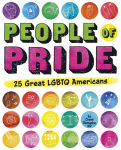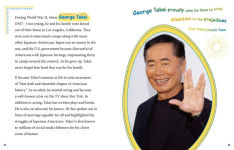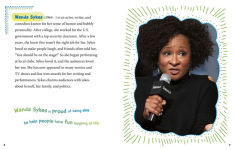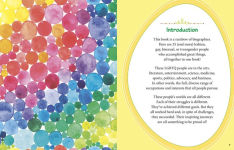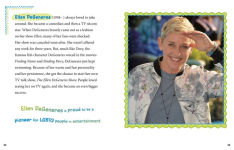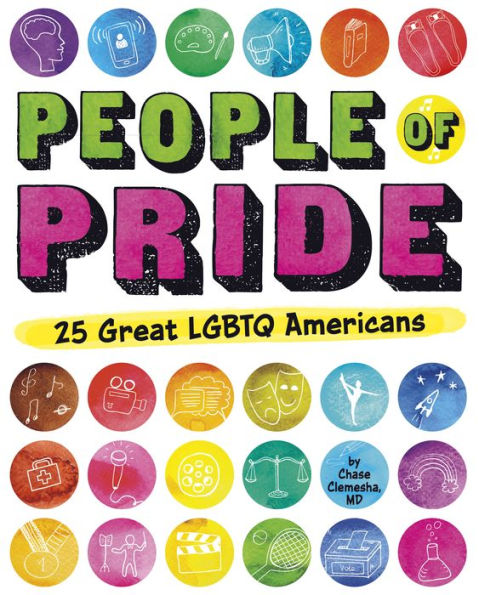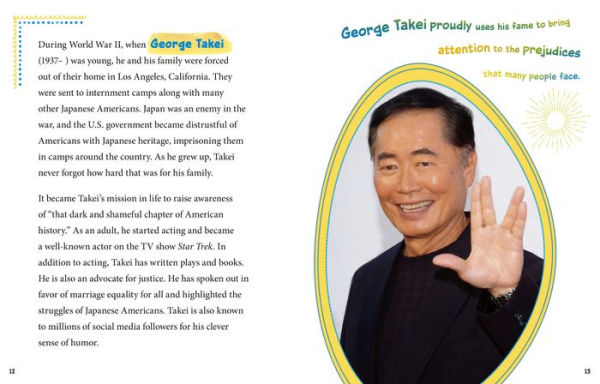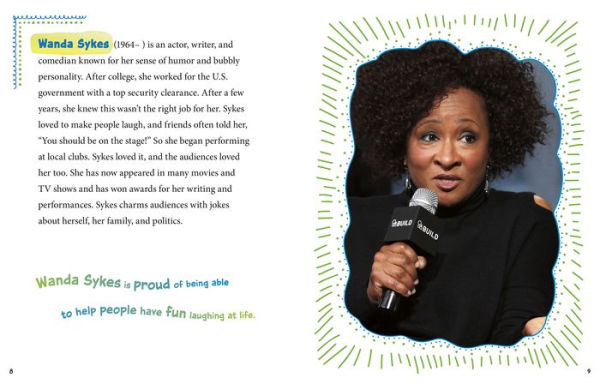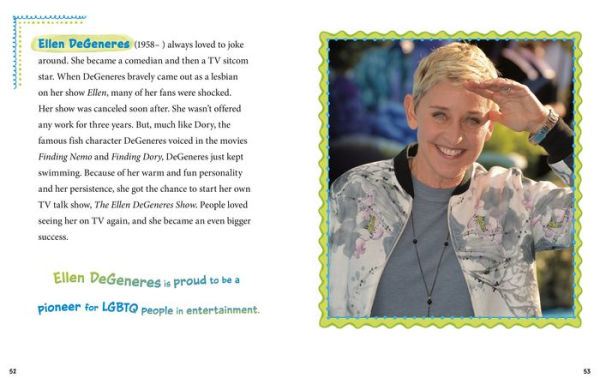Chase Clemesha, himself a medical doctor, writes in the introduction to his People of Pride: 25 Great LGBTQ Americans (Capstone Editions), “It’s important that young people have role models to look up to—especially people who are like them…. I want to show young people that they can decide who and what they’re going to be. If you are part of the LGBTQ community, it is a beautiful part of who you are, but it is only one part. You get to be proud of who you are—your whole self.” His book, aimed at middle-graders, offers a series of two-page spreads—a full-page photo and a page of text—about LGBTQ Americans who have excelled in their fields. There are civil right heroes, sports stars, artists and musicians, scientists, politicians, and lawmakers. Many of the figures are contemporary or nearly so, but Clemesha also weaves in earlier figures. It’s a nice balance. In addition to the 25 people highlighted, an additional 14 are listed at the end with short one- to two-sentence blurbs about them. Clemesha conveys each person’s impact simply and clearly, though some of the profiles feel just a little too flimsy. While I like this volume well enough, I still have a few observations. First, two wishes: I wish that at least one bisexual person had been identified as such. Not every figure in the book is labeled with their LGBTQ identity, which is understandable for the earlier figures who might not have thought in modern terms. We do find out the specific LGBTQ identities of some of the later ones, however—just none of them who are bi, making it unclear if there are even any bisexual people here. I also wish that in addition to teaching us about its subjects’ external accomplishments, the book could also have given us a little information about their families and relationships. Author Maurice Sendak lived with his partner Eugene Glynn for 50 years before Glynn’s death; several others were or are in relationships decades long; and several are parents—but we learn none of that here, beyond an in-passing comment that Wanda Sykes makes jokes about her family. A truly full vision of what LGBTQ people could be with their “whole selves” would show that LGBTQ people can make their mark in the world and have satisfying relationships and family lives, too—young people need to see that. . . . People of Pride is very similar to Sarah Prager’s 2020 Rainbow Revolutionaries: Fifty LGBTQ+ People Who Made History, another middle grade book that compiles short biographies of notable LGBTQ people. Prager showcases figures within and outside the United States and looks much further back in history; Clemesha sticks with U.S. figures whose impact has been primarily in the 20th and 21st centuries. Readers should appreciate both approaches, depending on their interests and moods. Although both are targeted at middle grade readers, Clemesha’s profiles are shorter, making them better for the younger end of that set; Prager dives a little deeper for readers wanting more. Prager’s glossary is much better, however, and she does touch on many of her subject’s relationships and family lives. While some of the figures in both books are the same, many are different, so readers may want to peruse both volumes. If I detailed some criticisms of People of Pride above, that’s only because I feel young readers may still find inspiration here. I’d love to see some of the issues, especially with the back matter, addressed in a future edition of what will likely be a valuable book for many young people.
2020-11-18
This amuse-bouche introduction to LGBTQ+ individuals will tantalize readers.
Some 25 racially diverse Americans’ lives are documented in biographical morsels, arranged apparently arbitrarily and with text that’s not substantial enough to do more than tease. Figures profiled include White humanitarian Jane Addams, African American civil rights activist Bayard Rustin, Puerto Rican performer Ricky Martin, and White filmmakers Lana and Lilly Wachowski. Each entry provides the subject’s year of birth (and of death, when applicable), a photo (in a digitally rendered frame reminiscent of 1990s clip art), and a few scant facts about each subject. George Takei, the Japanese American actor and activist, and Dr. Sara Josephine Baker, a White public health innovator, are lucky enough to merit two whole paragraphs; everyone else receives only one. Absent from all profiles are many common facts typically found in traditional biographies: Exact date of birth, place of birth, date of death, place of death, cause of death, etc., are all missing. Also peculiar is the absence from several profiles of the specific aspect of LGBTQ+ identity that warrants their inclusion. The backmatter includes a listing of 14 additional figures, summarized in two to three sentences each; such audience-relevant figures as African American author Jacqueline Woodson and Black/biracial actor Amandla Stenberg are relegated to this roundup. There are also a timeline that stops at 2015 (well before Trump administration politics started cutting into trans rights), a glossary, source notes, and three URLs for support networks.
Well meaning but insubstantial. (Collective biography. 8-12)



